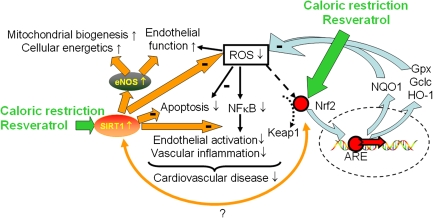Figure 3.
Proposed scheme for the mechanisms by which caloric restriction and the caloric restriction mimetic resveratrol confers vasoprotection. In aging, calorie restriction and resveratrol induce/activate SIRT1 and upregulate eNOS in the endothelial cells promoting mitochondrial biogenesis, restoring cellular energetics, attenuating mitochondrial oxidative stress, improving endothelial function, attenuating apoptotic cell death, and inhibiting NF-κB. Caloric restriction and/or resveratrol may also activate Nrf2 (NF-E2-related factor 2). Nrf2 is translocated to the nucleus and binds to the antioxidant response element, which upregulates antioxidant enzymes, increases glutathione synthesis (upregulating γ-glutamylcysteine synthetase), and induces the NQO1-dependent transplasma membrane–associated redox system. The model predicts that there is an interaction between SIRT1 and activation of Nrf2-dependent ROS detoxification pathways.

